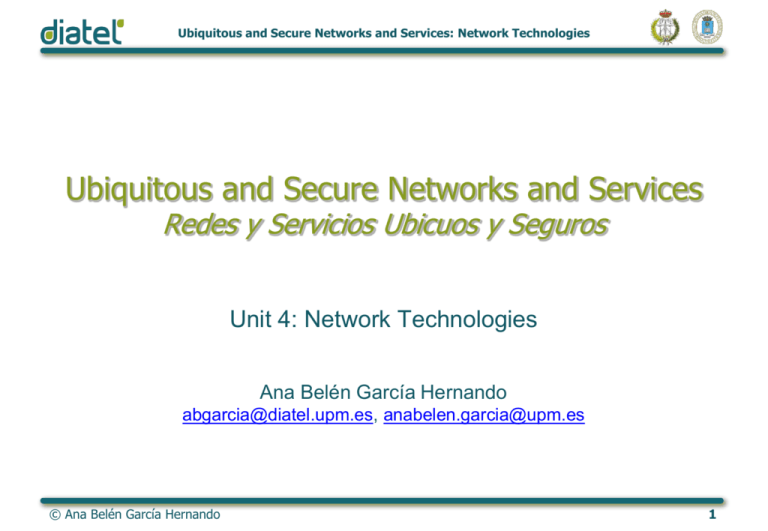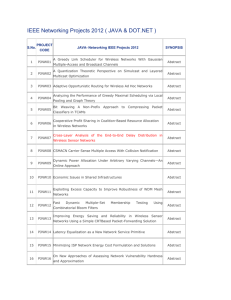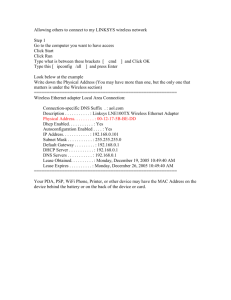
Ubiquitous and Secure Networks and Services: Network Technologies
Ubiquitous and Secure Networks and Services
Redes y Servicios Ubicuos y Seguros
Unit 4: Network Technologies
Ana Belén García Hernando
abgarcia@diatel.upm.es, anabelen.garcia@upm.es
© Ana Belén García Hernando
1
Ubiquitous and Secure Networks and Services: Network Technologies
Networking challenges in WSN
Low energy consumption [vs. QoS].
Cross-layer optimization (interrelations, and co-designs,
between different layers, e.g. link and routing protocols).
Low complexity and buffer space on the nodes.
Scalability.
Self-organization, self-healing, robustness, resilience.
Decentralized control ( less efficient but more robust and
scalable algorithms).
Data aggregation.
Possible absence of a global ID (new communication
paradigms: data-centric, location-based, …).
Unequal traffic load (usually communication flows from many
nodes to one or a few sinks: convergecast communication).
© Ana Belén García Hernando
2
Ubiquitous and Secure Networks and Services: Network Technologies
Energy consumption
Low energy consumption is
usually the most stringent
requisite.
The figure shows the energy
consumption of typical node
components in active mode (in
sleep mode the consumption is
negligible to this).
Low duty-cycle is a must for
many applications in order to last
enough time.
This may increase the delay
(sleep delay), especially in
multi-hop networks.
© Ana Belén García Hernando
Energy consumption of typical node components. Measurements taken with a
node using a CC2500 radio chip and MSP 430 MCU and typical accelerometers.
[Plancoulaine2006] S. Plancoulaine, A. Bachir, and D. Barthel. “WSN Node Energy
Dissipation”. France Telecom R&D, internal report. July 2006.
3
Ubiquitous and Secure Networks and Services: Network Technologies
Protocol stack
[Upper
layers]
• Applications.
• Transport layer (has received not much attention from the research
community).
Network
• End-2-end communication.
• Topologies and routing are among its main characteristics,
especially for multi-hop communication.
Data link
• Communication between neighbouring nodes.
• Medium Access Control (MAC) is the main design issue in WSN. It
coordinates the usage of a medium that is shared by several
nodes.
Physical
• Interface to the (wireless) transmission medium.
• Modulation, frequency bands, bit rate, …
© Ana Belén García Hernando
4
Ubiquitous and Secure Networks and Services: Network Technologies
Protocol stack
[Upper
layers]
• Applications.
• Transport layer (has received not much attention from the research
community).
Network
• End-2-end communication.
• Topologies and routing are among its main characteristics,
especially for multi-hop communication.
Data link
• Communication between neighbouring nodes.
• Medium Access Control (MAC) is the main design issue in WSN. It
coordinates the usage of a medium that is shared by several
nodes.
Physical
• Interface to the (wireless) transmission medium.
• Modulation, frequency bands, bit rate, …
© Ana Belén García Hernando
5
Ubiquitous and Secure Networks and Services: Network Technologies
Medium Access Control
Reservation-based
Contention-based
• There is a schedule for using the
shared medium. E.g., TDMA.
The scheduling can be centralized or
local-based (e.g. 2-hop schedules)
• May ensure fairness, avoids
collisions
• Requires knowing the topology and
sometimes also synchronization. The
establishment of the schedule produces
overhead and may not escale well. Not
very suitable for highly dynamic
environments, either in topology or in
traffic patterns.
• If several users try to transmit, there is a
collision. Eventually a winner will
succeed. E.g., CSMA.
• No need of global synchronization or
topology knowledge. Simpler than
reservation-based solutions.
• Possible collisions ( higher energy
consumption), performance drops when
load increases.
Many protocols for WSN adopt a hybrid approach of some kind:
preamble-sampling, hybrid schedule (contention / reserved),
different mechanisms in different parts of the network, …
© Ana Belén García Hernando
6
Ubiquitous and Secure Networks and Services: Network Technologies
MAC: Main causes of energy consumption
Collisions:
Transmitting the collided frames and their reception is a
waste of energy.
Overhearing:
Reception of irrelevant packets or signals.
Overhead:
Control packets and control information consumes energy.
Idle listening:
A radio not in sleep mode consumes a significant amount of
energy.
Ideally, the radio should be on only when transmitting or
receiving useful information.
This is not always achievable.
© Ana Belén García Hernando
7
Ubiquitous and Secure Networks and Services: Network Technologies
Example of MAC mechanism: CSMA/CA
Carrier sense multiple access with collision avoidance:
Contention-based, with an added mechanism to minimize
collision occurrence.
RTS: Request To Send.
RTS is small Low probability of collision.
CTS: Clear To Send.
Purpose: reserve the channel around the receiver. Nodes in
the vicinity will refrain from transmitting.
© Ana Belén García Hernando
8
Ubiquitous and Secure Networks and Services: Network Technologies
Figure 9. Preamble sampling. [Bachir2010] Bachir, A.; Dohler, M.;
Watteyne, T.; Leung, K.K. "MAC Essentials for Wireless Sensor
Networks". IEEE Communications Surveys & Tutorials. Volume: 12,
Issue: 2. 2010. Pp. 222 – 248.
Example of MAC mechanism:
preamble-sampling
Allows low-duty cycle, although there is a trade-off between:
Long check interval, which requires longer preamble.
Short preamble, which requires more frequent checking.
The pattern of the traffic determines the best check interval
length.
© Ana Belén García Hernando
9
Ubiquitous and Secure Networks and Services: Network Technologies
Introduction to IEEE 802.15.4 Standard
“This standard defines the protocol and interconnection of
devices via radio communication in a personal area network
(PAN). The standard uses carrier sense multiple access with
collision avoidance (CSMA-CA) medium access mechanism
and supports star as well as peer-to-peer topologies. The
media access is contention based; however, using the optional
superframe structure, time slots can be allocated by the PAN
coordinator to devices with time critical data. Connectivity to
higher performance networks is provided through a PAN
coordinator.” [802.15.4-2006]
Defines PHY and MAC layers.
© Ana Belén García Hernando
10
Ubiquitous and Secure Networks and Services: Network Technologies
IEEE 802.15.4 PHY
Frequency bands and data rates included in the standard:
Table 1—Frequency bands and data rates, reprinted with permission from IEEE Std. 802.15.42006,Wireless Medium Access Control (MAC) and Physical Layer (PHY) Specifications for LowRate Wireless Personal Area Networks (WPANs), Copyright 2006, by IEEE. The IEEE disclaims
any responsibility or liability resulting from the placement and use in the described manner.
© Ana Belén García Hernando
From IEEE Std. IEEE Std. 802.15.4-2006,Wireless Medium Access
Control (MAC) and Physical Layer (PHY) Specifications for Low-Rate
Wireless Personal Area Networks (WPANs), Copyright 2006, by IEEE.
All rights reserved.*
11
Ubiquitous and Secure Networks and Services: Network Technologies
IEEE 802.15.4 MAC: types of devices
Two types of devices:
RFD (Reduced Function Devices).
Can only act as end-devices. Are equipped with sensors
and/or actuators. May interact with a single FFD. Are
usually simple devices.
FFD (Full Function Devices).
Can act as end-devices or as coordinators.
A FFD capable of relaying messages is a coordinator.
One of these will be the PAN coordinator.
The PAN coordinator provides connectivity to higherperformance networks and is usually mains-powered.
© Ana Belén García Hernando
12
Ubiquitous and Secure Networks and Services: Network Technologies
IEEE 802.15.4 MAC: supported topologies
Peer-to-peer: any
device may
communicate with any
other device as long as
they are in range of one
another.
Star: The rest of the nodes (RFDs or FFDs)
only communicate with the PAN coordinator.
Figure 1—Star and peer-to-peer topology examples, reprinted with permission from IEEE Std. 802.15.42006,Wireless Medium Access Control (MAC) and Physical Layer (PHY) Specifications for Low-Rate
Wireless Personal Area Networks (WPANs), Copyright 2006, by IEEE. The IEEE disclaims any
responsibility or liability resulting from the placement and use in the described manner.
© Ana Belén García Hernando
This allows for the use
of more complex
topologies and multihop routing at higher
layers.
From IEEE Std. IEEE Std. 802.15.4-2006,Wireless Medium Access
Control (MAC) and Physical Layer (PHY) Specifications for Low-Rate
Wireless Personal Area Networks (WPANs), Copyright 2006,, by
IEEE. All rights reserved.*
13
Ubiquitous and Secure Networks and Services: Network Technologies
IEEE 802.15.4 MAC: PAN modes (I)
Beacon-enabled:
A coordinator transmits periodical beacons (with a period
adjustable in the range 15ms to 245s) that define a superframe
structure with an optional inactive portion.
Two parts in the active portion (hybrid MAC approach):
CSMA-CA
GTS (Guaranteed Time Slots)
The beacon also allows the devices to synchronize and indicates
if there is any data waiting in the coordinator to reach a device
(so that the device may ask for it).
Nonbeacon-enabled:
Unslotted CSMA-CA is used.
No GTS (Guaranteed Time Slots), no superframe structure.
© Ana Belén García Hernando
14
Ubiquitous and Secure Networks and Services: Network Technologies
IEEE 802.15.4 MAC: PAN modes (II)
Superframe structure (beacon-enabled mode):
Figure 66—An example of the super-frame
structure, reprinted with permission from
IEEE Std. 802.15.4-2006,Wireless Medium
Access Control (MAC) and Physical Layer
(PHY) Specifications for Low-Rate Wireless
Personal Area Networks (WPANs), Copyright
2006, by IEEE. The IEEE disclaims any
responsibility or liability resulting from the
placement and use in the described manner.
CAP: Contention Access Period: Slotted CSMA-CA.
CFP: Contention Free Period:
Contains a variable number of GTS (Guaranteed Time Slots).
Assigned by the coordinator for low-latency applications or for applications requiring a
minimum BW.
On a beacon-enabled PAN, a coordinator that is not the PAN coordinator shall
maintain the timing of two superframes:
the superframe in which its coordinator transmits a beacon (the incoming
superframe) and
the superframe in which it transmits its own beacon (the outgoing
superframe).
From IEEE Std. IEEE Std. 802.15.4-2006,Wireless Medium Access
Control (MAC) and Physical Layer (PHY) Specifications for Low-Rate
Wireless Personal Area Networks (WPANs), Copyright 2006,, by
IEEE. All rights reserved.*
© Ana Belén García Hernando
15
Ubiquitous and Secure Networks and Services: Network Technologies
Protocol stack
[Upper
layers]
• Applications.
• Transport layer (has received not much attention from the research
community).
Network
• End-2-end communication.
• Topologies and routing are among its main characteristics,
especially for multi-hop communication.
Data link
• Communication between neighbouring nodes.
• Medium Access Control (MAC) is the main design issue in WSN. It
coordinates the usage of a medium that is shared by several
nodes.
Physical
• Interface to the (wireless) transmission medium.
• Modulation, frequency bands, bit rate, …
© Ana Belén García Hernando
16
Ubiquitous and Secure Networks and Services: Network Technologies
Routing in WSN: influencing factors
Network dynamics
Mobile nodes, channel / node failures, energy depletion.
Node deployment
Node density, controlled (deterministic) vs. random
deployment
Energy considerations
Data delivery models and traffic patterns
Address-based vs. Data-centric approach
Node capabilities
Is there heterogeneity in the nodes?
Data aggregation/fusion
Topology
Flat, hierarchical, lineal
© Ana Belén García Hernando
17
Ubiquitous and Secure Networks and Services: Network Technologies
Data delivery models
Continuous
Event-driven
Query-driven
Hybrid: the case of your practical project.
© Ana Belén García Hernando
18
Ubiquitous and Secure Networks and Services: Network Technologies
Routing in WSN: types of routing protocols
Protocols “inherited” from conventional Ad-hoc wireless networks.
E.g. AODV (Ad hoc On Demand Distance Vector routing
algorithm): the one used in ZigBee.
Simple topology-unaware routing mechanisms.
E.g. Flooding and gossiping.
Very simple, but energy inefficient or incurring in high delays.
Data-centric: the routing is made based on the data itself (using for
instance attribute-based naming) instead of on global identifiers.
Usually it includes some sort of data aggregation or in-network
processing.
E.g. Directed Diffusion, SPIN.
For different classifications of routing protocols see [Karthickraja2010], [Lotf2010] or [Akkaya2005].
© Ana Belén García Hernando
19
Ubiquitous and Secure Networks and Services: Network Technologies
Routing in WSN: types of routing protocols (cont’d)
Hierarchical: combined with a cluster-based topology. May
include data aggregation in cluster heads.
E.g. LEACH, in which cluster heads are selected
dynamically.
Location-based: nodes know their location and the routing is
based on the location of source and destination.
E.g. GEAR.
Network flow and QoS-aware.
E.g. MMSPEED.
Energy-aware routing protocols.
© Ana Belén García Hernando
20
Ubiquitous and Secure Networks and Services: Network Technologies
QoS-aware routing
Usual QoS metrics:
Reliability.
Timeliness.
Guarantees are usually
statistical.
Some protocols are
capable of giving
differentiated
guarantees to more
than one traffic type.
© Ana Belén García Hernando
Figure 3. Protocol structure of each node. Felemban, E.; Chang-Gun Lee; Ekici, E. "MMSPEED:
multipath Multi-SPEED protocol for QoS guarantee of reliability and timeliness in wireless sensor
networks". IEEE Transactions on Mobile Computing, Volume: 5, Issue: 6. 2006. Pp. 738 – 754.
21
Ubiquitous and Secure Networks and Services: Network Technologies
Introduction to ZigBee
From [ZigBee-2008]:
“The ZigBee Alliance has
developed a very low-cost, very
low-power consumption, twoway, wireless communications
standard.”
“The IEEE 802.15.4-2003
standard defines the two lower
layers: the physical (PHY) layer
and the medium access control
(MAC) sub-layer. The ZigBee
Alliance builds on this foundation
by providing the network (NWK)
layer and the framework for the
application layer.”
© Ana Belén García Hernando
22
Ubiquitous and Secure Networks and Services: Network Technologies
ZigBee: Network topologies
Tree networks: hierarchical routing strategy. Tree networks may employ beacon-oriented
communication (IEEE 802.15.4). In this case “internal nodes coordinate their own star
networks and, at the same time, act as a slave in their parent’s star network. Internal nodes
must start their superframe suitably offset from their parent’s in order to avoid overlapping of
their active portions.”
Mesh networks allow full peer-to-peer communication. Only nonbeacon-enabled
communication is used.
© Ana Belén García Hernando
23
Ubiquitous and Secure Networks and Services: Network Technologies
ZigBee: Routing
ZigBee routing is based on AODV (Ad hoc On Demand
Distance Vector routing algorithm).
AODV is an “on-demand” (or reactive) routing protocol
because it creates (discovers) routes only when required by
the source node.
For discovering routes to destinations it uses route requests
(RREQ) and replies (RREP) messages that gather the
accumulated cost of the possible routes.
Costs may be based on a link quality estimation provided by
the IEEE 802.15.4 interface.
© Ana Belén García Hernando
24
Ubiquitous and Secure Networks and Services: Network Technologies
Why not IP for WSN?
The idea is having IP in every node instead of connecting WSN through
specific gateways.
Towards a seamless integration with Internet.
There are still important challenges to tackle:
Addressing scheme.
IP-based routing does not fit well with
data-centricity of some WSN
applications.
Compatibility with layer 2.
6LoWPAN centers on transmitting IPv6
data over IEEE 802.15.4 frames.
Limited resources of nodes.
Some initial implementations were
done consuming very few resources
(e.g. uIP, lwIP).
Header size Header compression.
© Ana Belén García Hernando
Internet usual transport
protocols are not tailored to
WSN-specific characteristics
E.g. e2e retransmissions made
by TCP. Some variants have
been devised.
IPv4 or IPv6?
IPv6 includes mechanisms that
may be useful in WSN
(increased address space,
stateless configuration
mechanisms, …).
25
Ubiquitous and Secure Networks and Services: Network Technologies
6LoWPAN
6LoWPAN Working Group (WG) from the Internet Engineering Task
Force (IETF) [6LoWPAN].
Goal: define how to transmit IPv6 packets over low power
wireless networks, with emphasis on the IEEE 802.15.4
standard.
Some important characteristics:
No need of configuration servers (no DHCP, no NAT).
Header compression to minimize header overhead.
Low footprint (initial implementations do not require more than a
32KB Flash ROM).
Some important WSN operating systems already include
implementations of 6LoWPAN:
Contiki.
TinyOS.
Open issues: optimal dynamic IP routing protocol for WSN,
plug&play capabilities, …).
© Ana Belén García Hernando
26
Ubiquitous and Secure Networks and Services: Network Technologies
Bibliography
[6LoWPAN] IETF 6LoWPAN Working Group. IPv6 over Low power WPAN. http://datatracker.ietf.org/wg/6lowpan/
[802.15.4-2006] IEEE Std 802.15.4™-2006: Wireless Medium Access Control (MAC) and Physical Layer (PHY) Specifications for Low-Rate
Wireless Personal Area Networks (WPANs). September 2006.
[Akkaya2005] Kemal Akkaya, Mohamed F. Younis "A survey on routing protocols for wireless sensor networks". Ad Hoc Networks 3(3). Pp.
325-349. 2005.
[Bachir2010] Bachir, A.; Dohler, M.; Watteyne, T.; Leung, K.K. "MAC Essentials for Wireless Sensor Networks". IEEE Communications Surveys
& Tutorials. Volume: 12, Issue: 2. 2010. Pp. 222 – 248.
[Baronti2007] Paolo Baronti, Prashant Pillai, Vince Chook, Stefano Chessa, Alberto Gotta, Y. Fun Hu. "Wireless Sensor Networks: a Survey on
the State of the Art and the 802.15.4 and ZigBee Standards". Computer Communications, Vol 30, Issue 7. 2007.
[Correia2010] Paulo Alexandre Correia da Silva Neves, Joel José Puga Coelho Rodrigues. "Internet Protocol over Wireless Sensor Networks,
from Myth to Reality". Journal of Communications, Volume 5, No. 3. 2010. Pp. 189-196.
[Felemban2006] Felemban, E.; Chang-Gun Lee; Ekici, E. "MMSPEED: multipath Multi-SPEED protocol for QoS guarantee of reliability and
timeliness in wireless sensor networks". IEEE Transactions on Mobile Computing, Volume: 5, Issue: 6. 2006. Pp. 738 – 754.
[Karthickraja2010] Karthickraja, N.P.; Sumathy, V. "A study of routing protocols and a hybrid routing protocol based on Rapid Spanning Tree
and Cluster Head Routing in Wireless Sensor Networks". International Conference on Wireless Communication and Sensor Computing,
2010 (ICWCSC 2010). Pp. 1 – 6.
[Kulik1999] Kulik, J.,Rabiner,W.,Balakrishnan, H. "Adaptive protocols for information dissemination in wireless sensor networks". Proceedings
of Fifth ACM/IEEE Mobicom Conference, 1999. Pp.174-185.
[Lotf2010] Lotf, J.J.; Ghazani, S.H.H.N. "Overview on routing protocols in wireless sensor networks". 2nd International Conference on Computer
Engineering and Technology (ICCET), 2010. Volume: 3. Pp. V3-610 - V3-614.
[Plancoulaine2006] S. Plancoulaine, A. Bachir, and D. Barthel. “WSN Node Energy Dissipation”. France Telecom R&D, internal report. July
2006.
[ZigBee-2008] ZigBee Alliance. ZigBee Specification. January 2008.
© Ana Belén García Hernando
27







